|
|
Archives: Study Guide: Choir Book Manuscript: Istorum est enim
The Choir Book Manuscript: Istorum est enim is a one-leaf (two-page) handwritten manuscript that was once part of a large 16th century choir book. The music (square notes) and Latin text were sung as part of the liturgy of a Catholic Mass. This leaf measures 570 mm x 860 mm (22½" x 34").
Guide (finding aid) to the Choir Book Manuscript: Istorum est enim
CONTENT & FORMAT
Choir Book
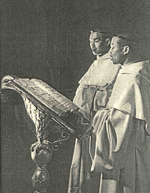 This leaf most likely comes from a 16th century choir book which provided the choir with the music and words for the chants that were used in a Catholic Mass. A choir book contained numerous music and text selections which were appropriate both for the type of Mass being celebrated and for the time of day. The portion of the Mass in this manuscript is the Common of Martyrs which was used to commemorate feasts of martyrs. It was also part of the daily liturgy called 'Vespers' which was the 7th liturgical "hour" sung in the late afternoon. This leaf most likely comes from a 16th century choir book which provided the choir with the music and words for the chants that were used in a Catholic Mass. A choir book contained numerous music and text selections which were appropriate both for the type of Mass being celebrated and for the time of day. The portion of the Mass in this manuscript is the Common of Martyrs which was used to commemorate feasts of martyrs. It was also part of the daily liturgy called 'Vespers' which was the 7th liturgical "hour" sung in the late afternoon.
The entire choir was able to read and sing from one large book. Books at this time were expensive, and a church or monastery may not have been able to provide a small missal or choir book for each choir member.
Liturgy
The liturgy or public worship of the Roman Catholic Church was composed of a variety of prayers, psalms, hymns, chants, responses, and biblical readings. This manuscript leaf contains antiphons and a versicle and response.
- Antiphon: An antiphon is a liturgical chant generally based upon a biblical verse and sung before and after a psalm or canticle.
- Versicle & Response: The versicle and response is sung by the cantor or celibrant and the assembly.
Text
The "Istorum est enim" antiphon came at the beginning of the Mass and was also sung before a psalm or the Magnificat, also known as the song of Mary.
Latin:
Istorum est enim regnu[m] celoru[m]
qui co[n]te[m]perseru[n]t vita[m] mu[n]di
Et perueneru[n]t ad premia regni
Et laveru[n]t stolas suas in saguine agni.
English:
[Blessed] are they who have despised earthly [pleasure], for theirs is the kingdom of heaven. They have washed their robes in the blood of the Lamb, and have won the heavenly [great] reward.
Biblical citation: Apocalypse (Revelation) 7:14.
|
|
|
The "Vestri capilli capitis" antiphon came towards the end of the Mass.
Latin:
Vestri capilli capitis omnes
[numerate sunt : nolite timere : multis passeribus meliores estis vos.]
English:
[Even] the very hairs of your head are all numbered; fear not [therefore]; you are of more value than many sparrows.
Biblical citation: Matthew 10:30-31 |
|
|
The "Letamini" versicle and response was generally sung after the antiphon.
Latin:
V: Letamini in Dno [Domino]: et exultate justi.
R. Et gloriamini, [omnes recti corde.]
English:
V. Be glad, O you righteous, and rejoice in the Lord.
R. And be joyful, all you that are true of heart.
|
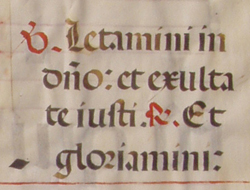 |
Music
The music in this manuscript is drawn in square notations on red lines making up five staves. The music was generally simple and was called Gregorian chant or plain chant.
MATERIALS & COMPOSITION
Folio
This double-sided sheet of music (one folio or leaf) was originally part of a large format choir book. It is probably one-half of a larger sheet of parchment which would have been folded in half to produce two leaves or four pages. These folded leaves were compiled into gatherings (also called quires or signatures) and then bound together in the proper order to make a book or codex.
This folio measures 570 mm x 860 mm (22½" x 34").
Parchment or Vellum
This music manuscript is made of parchment or vellum which is animal skin that has been processed and used for writing. Parchment and vellum have become generic terms and are often used interchangeably, but originally parchment referred to sheep and goat skin, and vellum referred to calf skin.
The flesh or 'inside' side of a sheet of parchment or vellum is generally whiter and softer than the hair side. The front page (recto) containing the "Istorum est enim" antiphon is probably the flesh side. The hair or 'outside' side of a sheet of parchment or vellum is generally darker and may show traces of hair follicles. The back page (verso) containing the "Vestri capilli capitis" antiphon is probably the hair side.
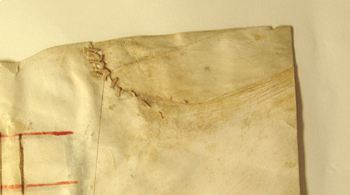 After the animal skin was soaked in water and lime, the hair was scraped away, and the skin was stretched and dried. Pumice was used to make the skin smooth and chalk was used to whiten the writing surface. Then the skin was cut to size. The resulting parchment or vellum sheet may have flaws or thin spots that required repair. After the animal skin was soaked in water and lime, the hair was scraped away, and the skin was stretched and dried. Pumice was used to make the skin smooth and chalk was used to whiten the writing surface. Then the skin was cut to size. The resulting parchment or vellum sheet may have flaws or thin spots that required repair.
This manuscript leaf has two areas that have been patched. The upper right-hand corner of the "Istorum" sheet has been repaired. A patch has been stitched and glued to the primary sheet. Notice the brush marks from the application of glue.
There is another small patch visible on the lower right-hand corner of the "Vestri" sheet.
Script & Ink
The script used in this manuscript is probably a Roman script commonly used in liturgical books. Ink was made from a solution of oak gall, gum, and carbon or lampblack.
The printed book was introduced around 1450, however, the production of handwritten religious books continued until about the middle of the 16th century.
Initials
|
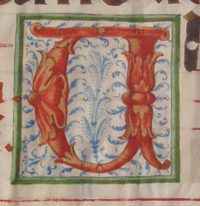 |
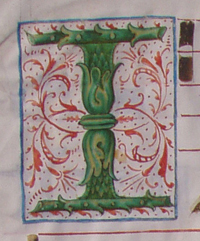 |
Initials are large letters that come at the beginning of a paragraph or passage. The initials in this music manuscript would have been produced by an illuminator who used red, green, and blue paints (probably tempera) to decorate the "I" and "V" at the beginning of each antiphon. It was common for the letter "V" to be written as a "U" and "U" as a "V."
Pricking
Pin pricks were used to mark either side of a manuscript page so that each line of text or music would be straight and even.
Omission of Letters
A squiggle, which in this text is a diamond mark, was placed above certain letters to indicate that a letter or letters, usually 'n' or 'm', was omitted. This was to save space; the words were understood despite the missing letters. The words to the right would be read as vitam mundi.

|
|
Production
The production of books often required a team of artists or craftsmen and craftswomen working together.
Place of Work
- Scriptorium, a room in a monastery or church where a book was made
- Workshop, a studio where artists worked under the direction of a master to produce books
Artists and Artisans
- Binder, a person who sews parchment or paper sheets together into a book and attaches it to a cover
- Parchmenter, a person who makes parchment
- Patron, a person who commissions and finances book production
- Scribe, a person who copies books and documents, a calligrapher
- Illuminator, an artist who decorates manuscripts with large initials, drawings, borders, flowers, and other decorations
- Stationer, a person who supplies materials to the artists and craftsmen/women
PROVENANCE
This manuscript was given to Lane Community College by Stanley Slotkin, a businessman who founded the Abbey Rents company. He was also a collector of rare books who frequently dissembled some of his books and donated individual leaves to libraries in the 1960s. The following notation appears at the bottom of each page of this manuscript.
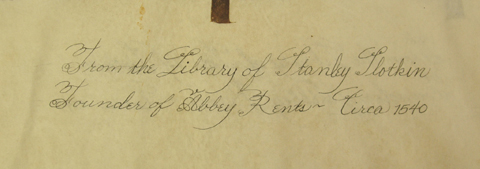
RESOURCES - Library
- The Dictionary of Art
- The New Grove Dictionary of Music & Musicians
- New Catholic Encyclopedia
RESOURCES - Online
GO TO:
Students and faculty are encouraged to contact the archivist for assistance in using this manuscript in the classroom or for research.
|
 |




